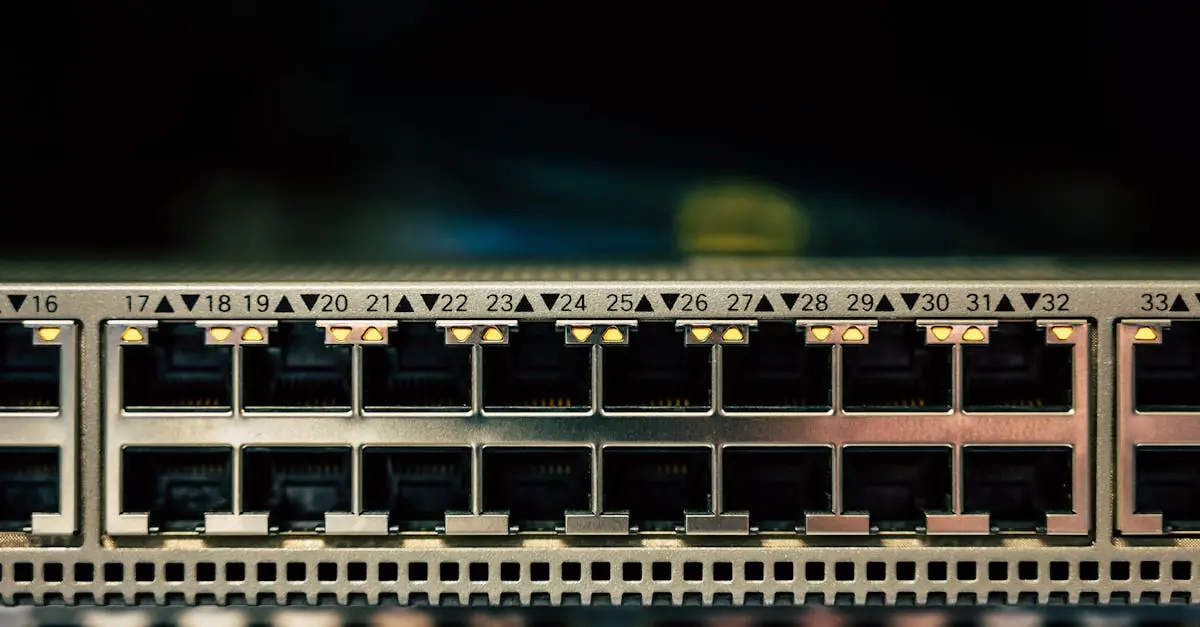In a world where connectivity reigns supreme, the Ethernet switch is the unsung hero of your network. Think of it as the traffic cop of data, expertly directing packets to their destinations while keeping the chaos at bay. Without it, your devices would be like cars in a jam, honking and going nowhere fast.
Table of Contents
ToggleOverview of Ethernet Switch
Ethernet switches play a vital role in facilitating communication within a network. These devices connect multiple computers and network segments, allowing for seamless data transfer. A fundamental characteristic of Ethernet switches is their ability to efficiently manage data packets. Packet switching enhances network speed and reduces collision domains, ensuring devices communicate without interference.
Multiple ports on an Ethernet switch enable the connection of various devices simultaneously. Each port operates independently, providing dedicated bandwidth to connected devices. This independence fosters a more organized network environment, preventing slowdowns associated with traditional hubs, where all devices share bandwidth.
Different types of Ethernet switches exist to meet diverse networking needs. Managed switches offer advanced features like VLAN support, traffic prioritization, and remote monitoring. Unmanaged switches provide basic connectivity and simplicity, making them suitable for small networks or home use.
Gigabit Ethernet switches support high-speed connections and accommodate data-heavy applications. Many organizations rely on these switches to support video conferencing, large file transfers, and cloud applications.
Switching technology continues to evolve, with innovations such as Power over Ethernet (PoE). PoE enables devices like IP cameras and wireless access points to receive power through Ethernet cables, simplifying installations.
Understanding the functionalities and types of Ethernet switches is essential for optimizing network performance. Managers and IT professionals can make informed decisions, ensuring their networks operate efficiently and effectively.
Key Features of Ethernet Switch
Ethernet switches come with several key features that enhance their functionality and efficiency in networking environments.
Port Configuration
Port configuration plays a crucial role in how switches manage traffic. Each Ethernet switch includes multiple ports that can vary from 5 to 48, depending on the model. Configurable port options enable users to tailor network setups. Additionally, many switches support auto-negotiation, allowing them to adjust speeds and settings based on connected devices. VLAN support enhances security and traffic management by segmenting the network into various groups, improving performance.
Speed and Performance
Speed and performance fundamentally define Ethernet switches’ effectiveness. Gigabit Ethernet switches support data transfer rates of 1 Gbps, facilitating quick communication, especially for data-heavy applications. High-performance switches often employ features like load balancing, which optimizes bandwidth usage among devices. Advanced buffering techniques further reduce packet loss during heavy traffic. These enhancements ensure that networks operate seamlessly, even under demanding conditions.
Managed vs Unmanaged Switches
Managed and unmanaged switches serve different networking needs. Managed switches provide advanced features, such as traffic monitoring and configuration options, suitable for larger, more complex networks. They enable control over traffic prioritization, providing quality of service for critical applications. On the other hand, unmanaged switches offer basic plug-and-play functionality, making them ideal for smaller setups with minimal configuration needs. Understanding these distinctions guides users in selecting the appropriate switch for their specific networking requirements.
Benefits of Using an Ethernet Switch
Efficient data management defines the primary benefit of utilizing an Ethernet switch. These devices enhance network performance by directing data packets precisely, allowing multiple devices to communicate effectively without delays or interruptions. Increased bandwidth distribution emerges as another significant advantage. Each port on an Ethernet switch provides dedicated bandwidth, which prevents the slowdowns typically seen with traditional hubs.
Moreover, scalability becomes a vital benefit when employing Ethernet switches. They support the addition of numerous devices without sacrificing performance. Flexibility in network design also helps organizations tailor setups to specific needs, ranging from small offices to expansive enterprises.
Enhanced security measures represent an added layer of protection. Managed Ethernet switches offer advanced features, such as Virtual Local Area Networks (VLAN) for segmenting traffic and prioritizing sensitive data transmissions. Reliability stands out as a critical factor as well, thanks to features like link aggregation, which increases network redundancy.
Additionally, cost-effectiveness manifests through the reduction of overall infrastructure requirements. Switches designed with Power over Ethernet (PoE) capabilities eliminate the need for separate power sources for devices, leading to simplified installations and decreased wiring costs.
Improved troubleshooting and network management also play essential roles in the benefits of Ethernet switches. Managed switches provide tools for monitoring traffic, which enables quick identification and resolution of issues. These measures contribute to overall network uptime, promoting productivity.
Ethernet switches offer numerous benefits, including efficient data management, increased bandwidth, scalability, enhanced security, reliability, cost-effectiveness, and improved troubleshooting. Organizations that leverage these devices can optimize their network performance and maintain seamless operations.
Applications of Ethernet Switch
Ethernet switches play a vital role in various networking environments. Their functionality adapts to different needs, from home settings to large enterprises.
Home Networks
Home networks benefit significantly from Ethernet switches. Multiple devices connect seamlessly, allowing for efficient data transfer during activities like streaming and gaming. High-speed connections enhance user experience, reducing latency. Switches also enable the integration of smart home devices, ensuring they operate smoothly and communicate effectively. Investing in a Gigabit Ethernet switch serves as a strong foundation for any modern home network, accommodating future device additions without a performance hit.
Business Networks
Businesses depend on Ethernet switches for robust network infrastructure. Many employees connect their devices simultaneously, so switches manage data traffic efficiently and minimize bottlenecks. They support advanced configurations, such as VLANs, optimizing resource allocation and improving security. Large organizations benefit from managed switches that offer enhanced monitoring and troubleshooting tools, ensuring consistent network uptime. High-speed connections play a crucial role in data-intensive applications, contributing to overall productivity and streamlined operations.
Common Brands and Models
Several prominent brands dominate the Ethernet switch market. Cisco, known for its advanced networking solutions, offers a variety of managed switches such as the Catalyst series, which excels in performance and scalability. Netgear provides reliable options, with models like the GS724T, offering extensive management features perfect for small to medium-sized networks.
TP-Link stands out with its TL-SG108E model, a cost-effective choice that balances performance and simplicity. HPE’s Aruba line features robust switches designed for enterprise environments, ensuring high availability and extensive control. Juniper Networks focuses on high-capacity Ethernet switches, such as the EX series, catering to data-intensive applications in large enterprises.
D-Link’s DGS series delivers reliable unmanaged switches ideal for entry-level setups. Linksys offers models like the LGS116, combining ease of use with essential features for home and small office environments. Ubiquiti’s Unifi Switches integrate seamlessly into their networking ecosystem, appealing to users seeking a comprehensive solution.
When assessing switch performance, speed remains a crucial factor. Gigabit switches, such as those from Cisco and Netgear, adequately support data-heavy applications. Power over Ethernet switches, like those from TP-Link, facilitate simpler installations by providing power and data through a single Ethernet cable.
These brands present diverse models tailored to various networking needs, whether for home, small business, or enterprise applications. Identifying the right brand and model depends on specific requirements, including budget, network size, and performance expectations. Selecting an appropriate Ethernet switch can significantly enhance network efficiency and reliability.
Ethernet switches are indispensable in today’s networking landscape. They not only streamline data flow but also enhance overall network performance. By providing dedicated bandwidth and efficient data management, these devices cater to both home and business environments.
Investing in the right Ethernet switch can lead to significant improvements in speed and reliability. Whether opting for a managed or unmanaged switch, understanding specific needs is crucial. With the right selection, users can ensure their networks are equipped to handle current demands and future growth effectively.





